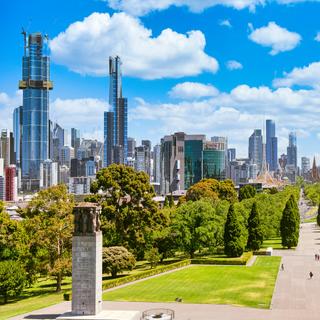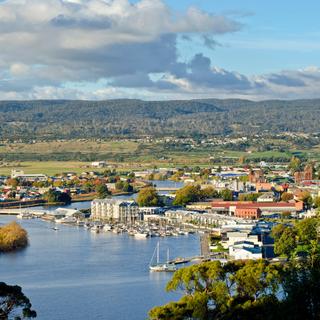Ballarat weather and climate in 2025
Day
23 °C
Night
9 °C
Sea
16 °C
Precipitation
54 mm
in month
Rainy days
8 days
in month
Daylight
15 hours
average
Sunshine
8 hours
average
Humidity
51 %
Weather charts for Ballarat
Find more destinations like this
Closest destinations for Ballarat
Closest cities for Ballarat
Weather overview for Ballarat
Weather overview
Experiencing all four seasons, Ballarat in Victoria, Australia, offers a varied climate with ranging temperatures and precipitation. It begins its year with warm summers with highs of around 25.3 degrees Celsius in January. As autumn approaches, the city cools notably with daytime temperatures decreasing to about 14.8 degrees Celsius by May. Winter months bring chilly nights, particularly in July with temperatures dropping as low as 3 degrees Celsius. Spring, starting in September, sees the environment rejuvenate with increasing temperatures and longer sun hours. Rainfall is moderate throughout the year, making Ballarat's weather quite pleasant with clear, crisp air and a mixture of sunny and rainy days.
January weather
January in Ballarat graces residents with comfortable warm weather, averaging daytime temperatures of 25 °C (78 °F). With January being in the dry season, you can expect a limited number of rainy days, typically around 6 days. It's a time filled with abundant sunshine, where sun hours reach an approximated 9 hours daily. The cool winds keep the evenings pleasant with an average wind speed of 5 m/s.
February weather
February continues to delight with warm weather as temperatures peak at an average of 26 °C (78 °F) during the day. February's weather is much like January's, with moderate rainy days tallying approximately 5 days and high relative humidity at 51 %. This suggests that the evenings might feel a bit milder than the actual temperature indicator. A light breeze continues to comfort residents and visitors with an average wind speed of 4 m/s.
March weather
As March approaches, you will notice a slight decrease in daytime temperatures that hover around 23 °C (73 °F). March marks the transition from summer to autumn, which means changes in the weather patterns. With almost 7 days of rain, it's a period when brief showers become more frequent, although the dry weather still prevails. An average wind speed of 4 m/s along with a relative humidity of 54 % provides a gentle reminder of the transitioning season.
April weather
April in Ballarat brings further cooling, especially during night time, with an average minimum temperature of 7 °C (45 °F). Daylight hours lessen as autumn progresses with 53 for the month and you'll observe more rainy days, approximately 8 days. Slightly stronger winds at an average of 4 m/s accompany the cooler weather, and the rainfall increases to 47 mm (1.83 in), indicating the onset of wetter conditions.
May weather
The month of May marks a transition towards cooler, crisper weather with daytime highs dropping to around 15 °C (59 °F). Rainfall becomes more prevalent with about 11 days of rain on average, and a total precipitation of 55 mm (2.15 in). The increase in humidity (reaching 71 %) and reduced sun hours, now at about 4 hours, adds a certain moistness to the air, laying the foundation for the coming winter.
June weather
June welcomes the winter season in Ballarat with an average daytime temperature of 12 °C (53 °F) and the chilliest nights of the year, as temperatures can fall to about 4 °C (39 °F). Increased precipitation at 62 mm (2.42 in) and a slightly higher count of wet days at 13 days mean that rain can often be a regular occurrence. The shortened daylight hours, now at 3 hours, and higher winds with speeds averaging 5 m/s give June a more brisk and biting climate.
July weather
July solidifies its reputation as Ballarat's coldest month, with average night lows at a mere 3 °C (37 °F). Day highs don't offer much respite either, averaging at 11 °C (51 °F). Rainy days continue with approximately 13 days, yet the amount of rainfall is moderate, tallying at 64 mm (2.54 in). The relative humidity remains high at 75 %, making for damp and often foggy conditions. Blusterous winds at an average of 4 m/s help disperse the fog and add a brisk touch to the cool air.
August weather
August in Ballarat starts to hint at the coming of spring. While still cool, daytime temperatures edge upwards to an average of 12 °C (53 °F). Nights remain chilly at an average of 3 °C (38 °F). The wind speed stays elevated at 5 m/s, cutting through the still-crisp air. The number of rainy days rises slightly to 14 days, but the rain volume, at about 71 mm (2.78 in), indicates wetter conditions persisting.
September weather
September signifies the blossom of spring in Ballarat, with temperatures climbing to an average high of 14 °C (58 °F) during the day. Though warmer than winter, rain continues to be a companion with about 13 days of showers. The rain volume isn't too high, standing at 67 mm (2.63 in), suggesting that spring showers may be manageable. With the air becoming drier, relative humidity drops to 65 %, and the days gradually get longer with an average of 5 hours of sun.
October weather
October's arrival brings further warming with average daytime highs of 17 °C (63 °F) and an overall feel of spring truly settling in. Ballarat’s weather sees a slight decrease in the number of rainy days to about 11 days while the humidity levels out at 59 %. Blustery winds at an average of 5 m/s can still be felt, but the sun hours increase to around 6 hours, shining a light on the emerging warmth.
November weather
As November arrives, the anticipation for summer is tangible with day temperatures reaching an average of 20 °C (68 °F). Rain still makes its presence felt, albeit less so, with about 9 days of rainy days. The weather is setting up for the warm period ahead, with the relative humidity dialing down to 56 % and sun hours extending to 7 hours.
December weather
December witnesses the onset of summer in Ballarat, with temperatures peaking at an average high of 23 °C (73 °F). Rainy days dwindle to around 8 days and the atmosphere remains moderately humid with 51 %. Ample sunlight at an average of 8 hours bathes the city in warmth, creating a pleasant pre-holiday season climate.
FAQs
Will I need to carry an umbrella often in Ballarat during January?
With only about 6 days of rain in January, you might leave your umbrella at home on most days. However, it's always a wise idea to check the local forecast before planning your outdoor activities.
Is February in Ballarat prone to heavy rainfall?
February in Ballarat isn't known for heavy rainfall, as it has an average of 5 days of rain. Bringing a light jacket or umbrella for sudden showers is a good precaution while you enjoy the generally dry weather.
Does Ballarat start cooling down in March?
Yes, March in Ballarat is noticeably cooler than the summer months, as it displays a gradual decline in high temperatures to an average of 23 °C (73 °F).
What can I expect from Ballarat's weather in April?
April in Ballarat will have you experiencing cooler temperatures and a greater chance of rain, with an impressive 47 mm (1.83 in) falling over 8 days. Keep a sweater handy for the evening chill and don't forget your raincoat or umbrella for potential showers.
How chilly does it get during the day in Ballarat in May?
Daytime in May sees a noticeable dip in temperatures with the highs averaging 15 °C (59 °F), hinting at the need for warmer outfits to cope with the fresh climate.
What kind of temperatures can I expect in Ballarat during June?
June in Ballarat can be quite cold with the mercury hitting an average daytime high of just 12 °C (53 °F). Nighttime can be particularly chilly, so extra layers and a warm duvet are recommended.
Is July very cold in Ballarat?
Yes, July in Ballarat can be quite cold, with temperatures typically hovering around 3 °C (37 °F) at night and reaching 11 °C (51 °F) during the day. Be prepared to bundle up and keep warm!
Does August see a significant weather change in Ballarat?
Weather in August in Ballarat changes subtly as the city slowly moves towards spring. It remains cool, but there's a slight increase in daytime temperatures, signaling the end of the colder days.
What type of climate does September bring to Ballarat?
September in Ballarat is mild and pleasant as spring starts to roll in. You'll experience moderate daytime temperatures that make outdoor activities enjoyable.
Is October a comfortable month weather-wise in Ballarat?
October is indeed comfortable in Ballarat with an agreeable climate as spring progress. The air is warmer and retains a freshness that is ideal for spending time outdoors.
Does November in Ballarat provide a prelude to summer?
Certainly, November in Ballarat introduces a pre-summer warmth with days becoming increasingly balmy and welcoming. It's a preview of the hotter days to come.
With summer starting, how hot does December get in Ballarat?
December signals the beginning of summer in Ballarat, bringing warmer days with an average high temperature of 23 °C (73 °F). It's comfortably warm rather than hot, perfect for festive activities.
We make the most from 40 years of historical weather data to predict the best weather conditions.
Deciding on where to go for a holiday is hard sometimes. Get inspired by the most popular destinations.
We aggregate data from combining multiple weather sources to ensure accuracy of the highest order.







